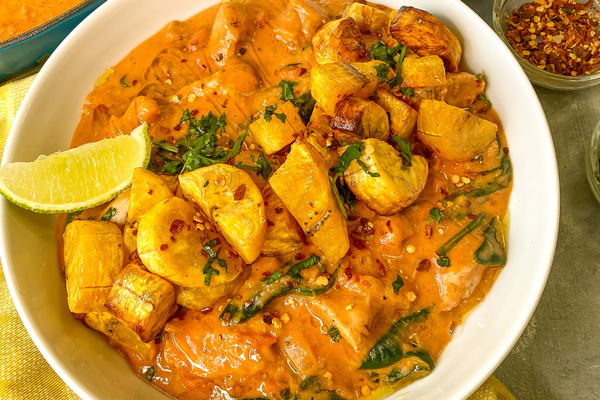Do you always feel as if you should lose a few pounds? Many of us think of ourselves as being overweight—even fat—when we're not close to that mark. Yet we watch the numbers on the scale and worry if our weight registers a pound or two (or kilogram) above what we've decided the right number ought to be.
That's because depriving ourselves of food seems an inevitable part of losing weight. When we look at our dinner plate while dieting, we often see more plate than dinner.
No wonder losing weight feels like a battle against ourselves. We're fighting our natural biological and psychological needs to have our appetites satisfied. Yet it's possible to eat ample meals, feel full, control hunger, have a nutritious diet and still lose weight or maintain weight loss.
Less is more
Scientists who study the body's feeling of fullness, called satiety, have shown that foods with high concentrations of calories in each portion increase our body weight and the overall amount of food we eat. The high energy density of foods such as fried onion rings or homemade chocolate chip cookies makes them taste appealing, but they don't create feelings of fullness until you've overeaten.
By contrast, foods with low energy density (vegetables and fruits, nonfat milk, cooked grains, soups, stews, lean protein), have fewer calories, but make us feel more full. They also promote weight loss.
Since most of us eat about the same weight of food every day, it makes a difference whether that food has a high or low energy density. If you combine big portions with high energy density—such as happens in many fast-food selections—you're cramming your daily food intake with too many calories.
Why water works
The key to keeping energy density low is water—not the stuff you drink from those cute little bottles, but the water content of foods. According to researcher Barbara J. Rolls, Ph.D., professor of nutritional sciences at The Pennsylvania State University in University Park, PA, and author of The Volumetrics Eating Plan (Harper Collins, 2005) and The Volumetrics Weight-Control Plan (Quill, 2000, HarperTorch, 2003) foods with low energy density are loaded with water. When you eat them, you can increase the volume of food you consume for the same, or fewer, calories.
To understand the influence of water on food volume—and its ability to dilute calories—consider that for a 100-calorie snack, you could eat either two cups of water-rich grapes or one-quarter cup of raisins (dried grapes). The volume of grapes you can eat for 100 calories is a more satisfying portion.
The most energy dense component of food is fat, at nine calories per gram. Water has zero calories per gram. So if you cut fat a bit and add more water (with vegetables, fruit or broth) in your cooking, you reduce energy density significantly.
Eating more fiber is also important for lowering energy density. High-fiber foods, such as whole-grain cereals and breads, help you feel full longer.
Calculating energy density
Understanding the energy density of foods and using it to guide eating choices, Rolls says, "can help people eat the way the research suggests they should be eating—not only for weight management, but for optimal health."
Here's a simple method she offers for determining the energy density (calories per gram) of foods you buy in the supermarket:
- Look at the Nutrition Facts label on the food package.
- Find the serving-size weight in grams and the calories per serving.
- If the calories are a smaller number than the grams, the food has low energy density. Feel free to enjoy satisfying amounts of that food.
- If the calories are equal to, or twice as much, as the grams, eat moderately and watch your portion size.
- If the calories are more than twice the grams, limit your portions.
You'll discover that dry foods, like crackers, have high energy density (calories more than twice the grams). Surprisingly, fat-free pretzels have the same energy density as cheese. Munching on these without controlling your portions can quickly add weight.
"Do a little pre-planning," says Jo-Anne Rizzotto, M.Ed., R.D., L.D.N., C.D.E., a registered and licensed dietitian at Joslin Diabetes Center, which is affiliated with Harvard Medical School, Boston. "Fill snack baggies with cut-up vegetables or cut-up melon, strawberries or any fruit and line them up in the refrigerator so you can just grab them to go for lunch or snacking on the run."
To add fiber and lower energy density, Rizzotto recommends looking for breads with at least three grams of fiber per serving and cereals or starches with at least five grams of fiber per serving. In recipes, she suggests using smaller amount of potatoes and using more vegetables like green beans, spinach, cauliflower, peppers, mushrooms and zucchini.
Add another course
It may seem hard to believe, but when you add an additional course to your meal—increasing food volume—you can reduce the overall number of calories you consume.
Rolls and her colleagues conducted a study in which women were given a first course of a large portion (three cups) of low-energy-dense salad. The salad was made with greens, vegetables, nonfat Italian dressing and reduced-fat cheese. Following that, the participants ate a main course of pasta.
Eating the salad boosted the women's feelings of fullness and reduced their total meal calorie intake. In other studies, having a first-course soup instead of the salad produced similar results.
Why does this work? "You get an awful lot of food without many calories," Rolls explains, "which then helps to displace the calories in the next course of higher energy dense foods." Simply drinking more water doesn't have the same effect.
Tips for low-energy-density eating
- Want to add a starter salad to your lunch or dinner? Remember to keep the energy density low. That means you can fill your bowl to the brim with greens, veggies, and low-fat dressing, but use only a very small amount—if any—of full-fat cheese or dressings, croutons or bacon bits.
- When choosing soup as a first course or snack, make it broth-based, such as chicken with rice or vegetable soup. Creamed soups, chowders and hearty bean soups have more calories and higher energy density. They're better as main dishes.
- Double the vegetables in your favorite recipes, from chili and beef stew to pasta or chicken salad.
- Watch what you drink. Each regular soda adds 150 unneeded calories to your daily total. Instead, choose water, tea, coffee (not the fat-laden specialty drinks!), diet soda, or add a splash of fruit juice to seltzer. Alcohol has a high energy density, so limit your daily consumption to one glass or less.
Full-plate menus
In The Volumetrics Eating Plan, Rolls provides satisfying, 1,400-calorie-a-day menus (and recipes), with choices based on the principles of energy density—foods that are rich in water, high in fiber, low fat, or lean protein, with low-calorie beverages and portion control for high-energy-dense selections.
Here are her suggested menus for two days:
| MENU #1: | |
| Breakfast: |
1 cup wheat bran flakes 1/2 cup blueberries 1 banana 1 cup 1% milk |
| Lunch: |
Roasted portobello mushroom sandwich on a Kaiser roll 1/2 cup tabbouleh 1 pear |
| Dinner: |
Sautéed skinless chicken breast with vegetables and Canadian bacon 2/3 cup brown rice 1-3/4 cups mixed greens and fennel salad 1 cup strawberries tossed with a bit of sugar and balsamic vinegar |
| MENU #2: | |
| Breakfast: |
1 packet instant oatmeal 1/4 cup oat bran 1/4 cup raisins 1 cup 1% milk |
| Lunch: |
One wedge of vegetable pizza, made with nonfat mozzarella 1-2/3 cups chilled gazpacho 1 snack cup, nonfat chocolate pudding |
| Dinner: |
Baked fish fillets with sautéed vegetables 2/3 cup oven-roasted potatoes 3/4 cup roasted asparagus fresh fruit dipped in chocolate fondue |







